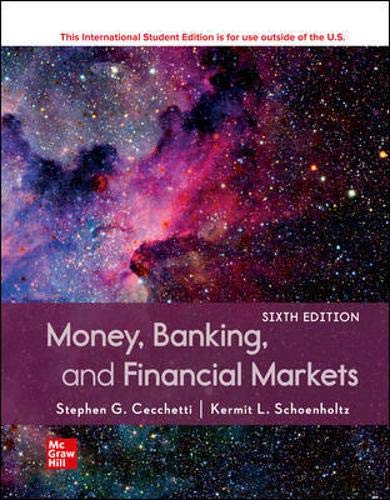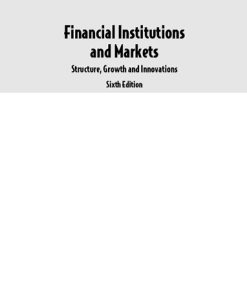Money Banking and Financial Markets 6th Edition by Stephen Cecchetti 1264058713 9781264058716
$50.00 Original price was: $50.00.$25.00Current price is: $25.00.
Money, Banking and Financial Markets 6th Edition by Stephen G. Cecchetti – Ebook PDF Instant Download/DeliveryISBN: 1264058713 9781264058716
Full download Money, Banking and Financial Markets 6th Edition after payment.

Product details:
ISBN-10 : 1264058713
ISBN-13 : 9781264058716
Author : Stephen G. Cecchetti
Money, Banking and Financial Markets
Money, Banking and Financial Markets 6th Table of contents:
Chapter 1: An Introduction to Money and the Financial System
Chapter 1 Introduction
The Six Parts of the Financial System
The Five Core Principles of Money and Banking
Core Principle 1: Time Has Value
Core Principle 2: Risk Requires Compensation
Core Principle 3: Information Is the Basis for Decisions
Core Principle 4: Markets Determine Prices and Allocate Resources
Core Principle 5: Stability Improves Welfare
Special Features of This Book
Your Financial World
Applying the Concept
Lessons from the Crises
Money and Banking Blog
Tools of the Trade
End-of-Chapter Sections
The Organization of This Book
Key Terms
Using FRED: Codes for Data in Chapter 1
Chapter Lessons
Conceptual and Analytical Problems
Data Exploration
Appendix A to Chapter 1
Measuring Economic Activity, Prices, and the Inflation Rate
Appendix B to Chapter 1
Using FRED
Chapter 2: Money and the Payments System
Chapter 2 Introduction
Money and How We Use It
Means of Payment
Unit of Account
Store of Value
The Payments System
Commodity and Fiat Monies
Checks
Electronic Payments
The Future of Money
Measuring Money
Key Terms
Using FRED: Codes for Data in Chapter 2
Chapter Lessons
Conceptual and Analytical Problems
Data Exploration
Chapter 3: Financial Instruments, Financial Markets, and Financial Institutions
Chapter 3 Introduction
Financial Instruments
Uses of Financial Instruments
Characteristics of Financial Instruments: Standardization and Information
Underlying versus Derivative Instruments
A Primer for Valuing Financial Instruments
Examples of Financial Instruments
Financial Markets
The Role of Financial Markets
The Structure of Financial Markets
Characteristics of a Well-Run Financial Market
Financial Institutions
The Role of Financial Institutions
The Structure of the Financial Industry
Key Terms
Using FRED: Codes for Data in Chapter 3
Chapter Lessons
Conceptual and Analytical Problems
Data Exploration
Chapter 4: Future Value, Present Value, and Interest Rates
Chapter 4 Introduction
Valuing Monetary Payments Now and in the Future
Future Value and Compound Interest
Present Value
Applying Present Value
Internal Rate of Return
Bonds: The Basics
Real and Nominal Interest Rates
Key Terms
Using FRED: Codes for Data in Chapter 4
Chapter Lessons
Conceptual and Analytical Problems
Data Exploration
Appendix to Chapter 4
The Algebra of Present-Value Formulas
Chapter 5: Understanding Risk
Chapter 5 Introduction
Defining Risk
Measuring Risk
Possibilities, Probabilities, and Expected Value
Measures of Risk
Risk Aversion, the Risk Premium, and the Risk-Return Tradeoff
Sources of Risk: Idiosyncratic and Systematic Risk
Reducing Risk through Diversification
Hedging Risk
Spreading Risk
Key Terms
Using FRED: Codes for Data in Chapter 5
Chapter Lessons
Conceptual and Analytical Problems
Data Exploration
Appendix to Chapter 5
The Mathematics of Diversification
Chapter 6: Bonds, Bond Prices, and the Determination of Interest Rates
Chapter 6 Introduction
Bond Prices
Zero-Coupon Bonds
Fixed-Payment Loans
Coupon Bonds
Consols
Bond Yields
Yield to Maturity
Current Yield
Holding Period Returns
The Bond Market and the Determination of Interest Rates
Bond Supply, Bond Demand, and Equilibrium in the Bond Market
Factors That Shift Bond Supply
Factors That Shift Bond Demand
Understanding Changes in Equilibrium Bond Prices and Interest Rates
Why Bonds Are Risky
Default Risk
Inflation Risk
Interest Rate Risk
Key Terms
Using FRED: Codes for Data in Chapter 6
Chapter Lessons
Conceptual and Analytical Problems
Data Exploration
Chapter 7: The Risk and Term Structure of Interest Rates
Chapter 7 Introduction
Ratings and the Risk Structure of Interest Rates
Bond Ratings
Commercial Paper Ratings
The Impact of Ratings on Yields
Differences in Tax Status and Municipal Bonds
The Term Structure of Interest Rates
The Expectations Hypothesis
The Liquidity Premium Theory
The Information Content of Interest Rates
Information in the Risk Structure of Interest Rates
Information in the Term Structure of Interest Rates
Key Terms
Using FRED: Codes for Data in Chapter 7
Chapter Lessons
Conceptual and Analytical Problems
Data Exploration
Chapter 8: Stocks, Stock Markets, and Market Efficiency
Chapter 8 Introduction
The Essential Characteristics of Common Stock
Measuring the Level of the Stock Market
The Dow Jones Industrial Average
The Standard & Poor’s 500 Index
Other U.S. Stock Market Indexes
World Stock Indexes
Valuing Stocks
Fundamental Value and the Dividend-Discount Model
Why Stocks Are Risky
Risk and the Value of Stocks
The Theory of Efficient Markets
Investing in Stocks for the Long Run
The Stock Market’s Role in the Economy
Key Terms
Using FRED: Codes for Data in Chapter 8
Chapter Lessons
Conceptual and Analytical Problems
Data Exploration
Chapter 9: Derivatives: Futures, Options, and Swaps
Chapter 9 Introduction
The Basics: Defining Derivatives
Forwards and Futures
Margin Accounts and Marking to Market
Hedging and Speculating with Futures
Arbitrage and the Determinants of Futures Prices
Options
Calls, Puts, and All That: Definitions
Using Options
Pricing Options: Intrinsic Value and the Time Value of the Option
The Value of Options: Some Examples
Swaps
Interest Rate Swaps
Credit Default Swaps
Key Terms
Using FRED: Codes for Data in Chapter 9
Chapter Lessons
Conceptual and Analytical Problems
Data Exploration
Chapter 10: Foreign Exchange
Chapter 10 Introduction
Foreign Exchange Basics
The Nominal Exchange Rate
The Real Exchange Rate
Foreign Exchange Markets
Exchange Rates in the Long Run
The Law of One Price
Purchasing Power Parity
Exchange Rates in the Short Run
The Supply of Dollars
The Demand for Dollars
Equilibrium in the Market for Dollars
Shifts in the Supply of and Demand for Dollars
Explaining Exchange Rate Movements
Government Policy and Foreign Exchange Intervention
Key Terms
Using FRED: Codes for Data in Chapter 10
Chapter Lessons
Conceptual and Analytical Problems
Data Exploration
Appendix to Chapter 10
Interest Rate Parity and Short-Run Exchange Rate Determination
Chapter 11: The Economics of Financial Intermediation
Chapter 11 Introduction
The Role of Financial Intermediaries
Pooling Savings
Safekeeping, Payments System Access, and Accounting
Providing Liquidity
Diversifying Risk
Collecting and Processing Information
Information Asymmetries and Information Costs
Adverse Selection
Solving the Adverse Selection Problem
Moral Hazard: Problem and Solutions
Financial Intermediaries and Information Costs
Screening and Certifying to Reduce Adverse Selection
Monitoring to Reduce Moral Hazard
Key Terms
Using FRED: Codes for Data in Chapter 11
Chapter Lessons
Conceptual and Analytical Problems
Data Exploration
Chapter 12: Depository Institutions: Banks and Bank Management
Chapter 12 Introduction
The Balance Sheet of Commercial Banks
Assets: Uses of Funds
Liabilities: Sources of Funds
Bank Capital and Profitability
Off-Balance-Sheet Activities
Bank Risk: Where It Comes from and What to Do about It
Liquidity Risk
Credit Risk
Interest Rate Risk
Trading Risk
Cyber Risk and Other Operational Risks
Other Risks
Key Terms
Using FRED: Codes for Data in Chapter 12
Chapter Lessons
Conceptual and Analytical Problems
Data Exploration
Chapter 13: Financial Industry Structure
Chapter 13 Introduction
Banking Industry Structure
A Short History of U.S. Banking
Competition and Consolidation
The Globalization of Banking
The Future of Banks
Nondepository Institutions
Insurance Companies
Pension Funds
Securities Firms: Brokers, Mutual Funds, and Investment Banks
Finance Companies
Government-Sponsored Enterprises
Key Terms
Using FRED: Codes for Data in Chapter 13
Chapter Lessons
Conceptual and Analytical Problems
Data Exploration
Chapter 14: Regulating the Financial System
Chapter 14 Introduction
The Sources and Consequences of Runs, Panics, and Crises
The Government Safety Net
The Unique Role of Banks and Shadow Banks
The Government as Lender of Last Resort
Government Deposit Insurance
Problems Created by the Government Safety Net
Regulation and Supervision of the Financial System
Restrictions on Competition
Asset Holding Restrictions and Minimum Capital Requirements
Disclosure Requirements
Supervision and Examination
Stress Tests
Evolving Challenges for Regulators and Supervisors
Micro-Prudential versus Macro-Prudential Regulation
Regulatory Reform: The Dodd-Frank Act of 2010
Key Terms
Using FRED: Codes for Data in Chapter 14
Chapter Lessons
Conceptual and Analytical Problems
Data Exploration
Chapter 15: Central Banks in the World Today
Chapter 15 Introduction
The Basics: How Central Banks Originated and Their Role Today
The Government’s Bank
The Bankers’ Bank
Stability: The Primary Objective of All Central Banks
Low, Stable Inflation
High, Stable Real Growth
Financial System Stability
Interest Rate and Exchange Rate Stability
Meeting the Challenge: Creating a Successful Central Bank
The Need for Independence
The Need for Accountability and Transparency
The Policy Framework, Policy Tradeoffs, and Credibility
Decision Making by Committee
Fitting Everything Together: Central Banks and Fiscal Policy
Key Terms
Using FRED: Codes for Data in Chapter 15
Chapter Lessons
Conceptual and Analytical Problems
Data Exploration
Chapter 16: The Structure of Central Banks: The Federal Reserve and the European Central Bank
Chapter 16 Introduction
The Structure of the Federal Reserve System
The Federal Reserve Banks
The Board of Governors
The Federal Open Market Committee
Assessing the Federal Reserve System’s Structure
Independence from Political Influence
Decision Making by Committee
Accountability and Transparency
Policy Framework
The European Central Bank
Organizational Structure
Accountability and Transparency
The Price Stability Objective and Monetary Policy Strategy
Key Terms
Using FRED: Codes for Data in Chapter 16
Chapter Lessons
Conceptual and Analytical Problems
Data Exploration
Chapter 17: The Central Bank Balance Sheet and the Money Supply Process
Chapter 17 Intoduction
The Central Bank’s Balance Sheet
Assets
Liabilities
The Importance of Disclosure
The Monetary Base
Changing the Size and Composition of the Balance Sheet
Open Market Operations
Foreign Exchange Intervention
Discount Loans
Cash Withdrawal
The Deposit Expansion Multiplier
Deposit Creation in a Single Bank
Deposit Expansion in a System of Banks
The Monetary Base and the Money Supply
Deposit Expansion with Excess Reserves and Cash Withdrawals
The Arithmetic of the Money Multiplier
The Limits of the Central Bank’s Ability to Control the Quantity of Money
Key Terms
Using FRED: Codes for Data in Chapter 17
Chapter Lessons
Conceptual and Analytical Problems
Data Exploration
Chapter 18: Monetary Policy: Stabilizing the Domestic Economy
Chapter 18 Introduction
The Federal Reserve’s Interest Rate Policy Toolbox
The Target Federal Funds Rate and the Interest on Reserve Balances
Discount Lending, the Lender of Last Resort, and Crisis Management
Operational Policy at the European Central Bank
The ECB’s Target Interest Rate and Open Market Operations
The Marginal Lending Facility
The Deposit Facility
Reserve Requirements
Linking Tools to Objectives: Making Choices
Desirable Features of a Policy Instrument
Inflation Targeting
A Guide to Central Bank Interest Rates: The Taylor Rule
Other Policy Tools
Reserve Requirements
Forward Guidance
Quantitative Easing
Targeted Asset Purchases
Making an Effective Exit
Concluding Remarks
Key Terms
Using FRED: Codes for Data in Chapter 18
Chapter Lessons
Conceptual and Analytical Problems
Data Exploration
Appendix to Chapter 18
Monetary Policy Operations and the Reverse Repo Rate
Chapter 19: Exchange Rate Policy and the Central Bank
Chapter 19 Introduction
Linking Exchange Rate Policy with Domestic Monetary Policy
Inflation and the Long-Run Implications of Purchasing Power Parity
Interest Rates and the Short-Run Implications of Capital Market Arbitrage
Capital Controls and the Policymakers’ Choice
Mechanics of Exchange Rate Management
The Central Bank’s Balance Sheet
Sterilized Intervention
The Costs, Benefits, and Risks of Fixed Exchange Rates
Assessing the Costs and Benefits
The Danger of Speculative Attacks
Summarizing the Case for a Fixed Exchange Rate
Fixed Exchange Rate Regimes
Exchange Rate Pegs and the Bretton Woods System
Hard Pegs: Currency Boards and Dollarization
Key Terms
Using FRED: Codes for Data in Chapter 19
Chapter Lessons
Conceptual and Analytical Problems
Data Exploration
Appendix to Chapter 19
What You Really Need to Know about the Balance of Payments
Chapter 20: Money Growth, Money Demand, and Modern Monetary Policy
Chapter 20 Introduction
Why We Care about Monetary Aggregates
The Quantity Theory and the Velocity of Money
Velocity and the Equation of Exchange
The Quantity Theory of Money
The Facts about Velocity
The Demand for Money
The Transactions Demand for Money
The Portfolio Demand for Money
Targeting Money Growth in a Low-Inflation Environment
The Instability of U.S. Money Demand
Targeting Money Growth: The Fed and the ECB
Key Terms
Using FRED: Codes for Data in Chapter 20
Chapter Lessons
Conceptual and Analytical Problems
Data Exploration
Chapter 21: Output, Inflation, and Monetary Policy
Chapter 21 Introduction
Output and Inflation in the Long Run
Potential Output
Long-Run Inflation
Monetary Policy and the Dynamic Aggregate Demand Curve
Aggregate Expenditure and the Real Interest Rate
Inflation, the Real Interest Rate, and the Monetary Policy Reaction Curve
The Dynamic Aggregate Demand Curve
Aggregate Supply
Short-Run Aggregate Supply
Shifts in the Short-Run Aggregate Supply Curve
The Long-Run Aggregate Supply Curve
Equilibrium and the Determination of Output and Inflation
Short-Run Equilibrium
Adjustment to Long-Run Equilibrium
The Sources of Fluctuations in Output and Inflation
What Causes Recessions?
Key Terms
Using FRED: Codes for Data in Chapter 21
Chapter Lessons
Conceptual and Analytical Problems
Data Exploration
Appendix to Chapter 21
The Dynamic Aggregate Demand–Aggregate Supply Model
Chapter 22: Understanding Business Cycle Fluctuations
Chapter 22 Introduction*
Sources of Fluctuations in Output and Inflation
Shifts in the Dynamic Aggregate Demand Curve
Shifts in the Short-Run Aggregate Supply Curve
Using the Aggregate Demand–Aggregate Supply Framework
How Do Policymakers Achieve Their Stabilization Objectives?
What Accounts for the Great Moderation?
What Happens When Potential Output Changes?*
What Are the Implications of Globalization for Monetary Policy?*
Can Policymakers Stabilize Output and Inflation Simultaneously?*
Key Terms
Using FRED: Codes for Data in Chapter 22
Chapter Lessons
Conceptual and Analytical Problems
Data Exploration
Chapter 23: Modern Monetary Policy and the Challenges Facing Central Bankers
Chapter 23 Introduction
The Monetary Policy Transmission Mechanism
The Traditional Channels: Interest Rates and Exchange Rates
Bank Lending and Balance Sheet Channels
Asset Price Channels: Wealth and Investment
Financial Crises and the Transmission of Monetary Policy
The Challenges Modern Monetary Policymakers Face
Booms and Busts in Property and Equity Prices
Deflation and the Effective Lower Interest Rate Bound
The Evolving Structure of the Financial System
Key Terms
Using FRED: Codes for Data in Chapter 23
Chapter Lessons
Conceptual and Analytical Problems
People also search for Money, Banking and Financial Markets 6th:
the economics of money banking and financial markets 13th edition
the economics of money banking and financial markets 12th edition
why study money banking and financial markets
borrow the economics of money banking and financial markets
the economics of money banking and financial markets global edition
Tags:
Money,Banking,Financial Markets,Stephen Cecchetti
You may also like…
Uncategorized
Business & Economics - Professional Finance
Business & Economics - Accounting
Accounting
Financial Institutions and Markets: Structure Growth and Innovations 6th Edition Jitendra Mahakud
Business & Economics - Mathematical Economics
The Economics of Money, Banking and Financial Markets, Seventh Canadian Edition Frederic S. Mishkin
Business & Economics - Economics
Managerial Economics: Economic Tools for Today’s Decision Makers, 6e 6th Edition Paul G. Keat
Politics & Philosophy - Politics












